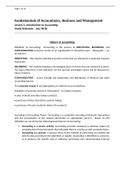Class notes
Class notes Fundamentals of Accountancy, Business, and Management (FABM11)
- Course
- Institution
Class notes for the subject Fundamentals of Accountancy, Business, and Management (FABM11) from Lesson 1 to 6. It started with the introduction of accounting. Followed by discussing the different branches of accounting. The users of financial information also tackle in lesson 4. Followed by the dif...
[Show more]



